Remembering one of the UK's worst rail crashes
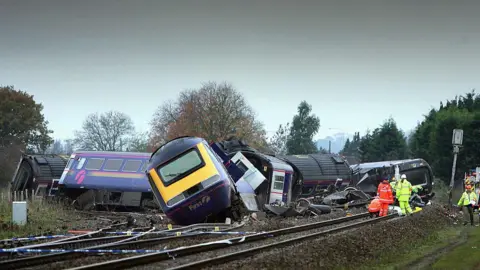 Getty Images
Getty ImagesSurvivors of one of the worst rail crashes this century will gather this evening to mark the 20th anniversary of the incident at Ufton Nervet in Berkshire.
At 12 minutes past six on 6 November 2004, a Great Western high-speed train struck a car at a level crossing between Theale and Newbury.
It had been parked in the path of the train by a local chef who intended to take his own life.
But the catastrophic derailment also took the lives of six other people. More than 70 passengers were taken to hospital with serious injuries.
A few had been hurled out of the train through shattered windows.
"It was like being inside a tumble dryer," recalled passenger Jane Hawker. "I had no idea whether I would live or die.
"With the perspective of 20 years, I can see how much it has influenced my life. I had a lot of counselling, a lot of therapy. I have successfully dealt with it."
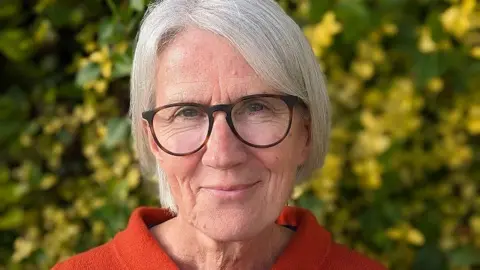
The train hit the car at almost 100mph. The car then jammed in a set of points beyond the crossing.
As the front of the train came off the rails and slowed down, the rear was still at full speed. The train jackknifed in the middle.
The train driver, Stan Martin, was among the dead.
'I didn't want to believe it'
Passengers Anjanette Rossi and her nine-year-old daughter Louella from Newbury both died.
"It was a very long night," says Ellener Bromfield, Anjanette's sister and Louella's aunt. "The following morning, I was still phoning my sister's mobile, because I didn't want to believe it. She didn't pick up.
"It changes you. Because your life has changed. I want to tell them about my children's children. I want to know how many children Louella should be having. So I get cross still."
 Getty Images
Getty ImagesTwelve years after the incident, the level crossing was closed and replaced by a bridge.
During the years in between, there had been four further fatal incidents at the same automatic half-barrier crossing.
More than 400 similar crossings remain.
At the inquest, the coroner heard that both the train and the level crossing had been operating correctly, and that no railway staff were at fault.
Network Rail's safety and engineering director, Martin Frobisher, said: "Serious accidents at level crossings are extremely rare.
"For many years now, we have been running a crossing closure programme with over 1,000 closed since Ufton Nervet."
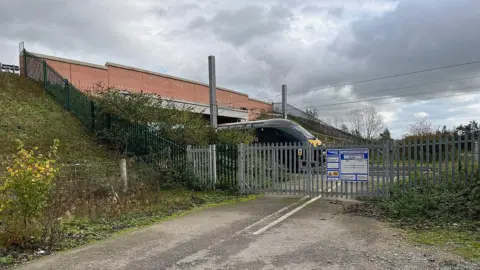
The number of deaths at level crossings has fallen by two-thirds in the decades since then, according to the Rail Safety and Standards Board, RSSB.
On average, two people a year still die on level crossings.
The type of train involved in the crash, dating from the 1970s, has now largely been withdrawn from service, though a few remain in use.
"We have done a lot of work on the crashworthiness of train vehicles and on their interior design. Modern vehicles have better protection in terms of glass and shatter resistance," said Mark Phillips, chief executive of RSSB.
"There has been an improvement in the safety risk at level crossings, to the point where it is no longer one of the biggest risks that the industry is concerned about."
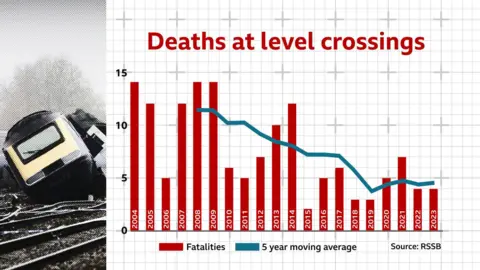
Ellener Bromfield, Jane Hawker and Julie Lloyds will join other families and survivors at a memorial garden alongside the site of the crash.
"I can't move on," said Ellener, who will bring her father. "It's always there in the background; there are too many things I still want to tell my sister. I don't like hearing a train. And I will never get on a train."
Jane has moved from Newbury to Devon. "I didn't go on trains at all until the level crossing at Ufton Nervet was replaced by a road bridge," she said. "Before that, I couldn't even stand on a station with a train going by.
"Among the survivors there was a real community. It was so extreme, it was outside the experience of my existing circle of friends. We needed each other."
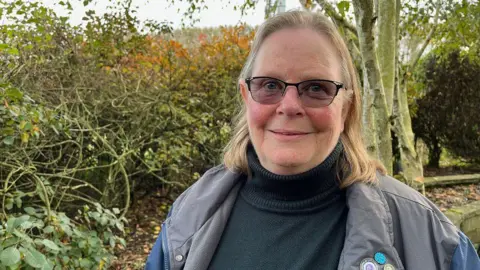
"I can remember it as if it was yesterday, unfortunately," said Julie, who survived the crash unscathed, but witnessed many others who did not. "It took a long time to get over it, but it's not something that rules my day any more.
"A think a lot of lessons were learned. I still wonder whether enough have been learned.
"Removing the level crossing made a lot of difference. I can relax when I go past here.
"To my mind, peace has returned to this area."
You can follow BBC Berkshire on Facebook, X (Twitter), or Instagram.
